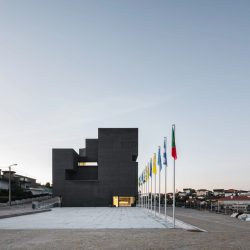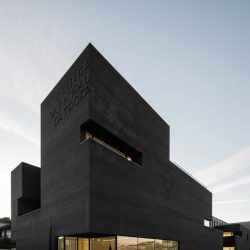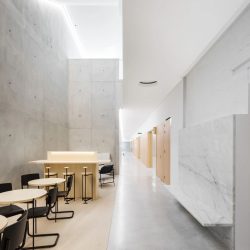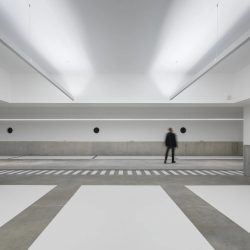
N O A R Q | noarquitectos . photos: © Attilio Fiumarella
Rehabilitation and expansion of the former of ‘Indústria Alimentar Trofense’ building into the Town Hall of municipality of Trofa.
The site is in the south of the urban centre on the edge of the now closed railway line route – an area where the city loses density and where the discontinuity of the urban fabric is visible.
The site covers 6,200.85 m2. The long, narrow geometry was parallel to the old railway line and ended in an ogive shape pointing the north.
A building emerged from the industrial complex. The seminal one stood out from other industrial buildings due to its architectural quality.
Considering the program required a substantial increase in area, an underground floor for parking and technical spaces and the widening the street to the east, we decided just to keep the main building.
Once the decision was made, to isolate and preserve the main building of the industrial complex, the description of the architectural composition reduces itself to a series of 5 juxtaposed narrow parallelepipeds between Rua Professor Mário Padrão and the extinct railway line.
The first parallelepiped was divided into 3 floors. It is used for the longitudinal circulation in the building, common to all services.
Two more blocks on each of the tops of the old building constitute the central mass of the City Hall. It is in these two volumes are concentrated all the municipal services, distributed in sequence of a 4 x 4 m modulation. Approximately in the middle of each of these parallelepipeds, there is a vertical block formed by the stairwells and toilets.
The fourth parallelepiped attached to the west façade was sculpted and lost its configuration. Its juxtaposition to the old building, preserving its relationship with the landscape, makes it the most sculptural volume in the group. The height varies up to a maximum of 4 floors.
Its function in the complex is to relate the different parts of the City Hall and to accommodate the social and the reception spaces of the citizens. Inside there is nothing. It is an empty space, with free height (triple or double), allowing visual contact between the different divisions that occupy the various levels of the building, allowing visual contact between the different offices on the different floors of the building.
The fifth parallelepiped has the same role and the same interior emptiness of the last one. It is in the south of the complex, placed in transversal position. Its existence invites the development of the (missing) urban space to the south of the city.
There is a sixth volume, but it is not visible. It is underground beneath all other volumes and is used for parking, technical services and storage.
The result is a building with a footprint of 1,996.00 m2 and a maximum height of 17.14 m.
The building is eminently constructive, accomplish the assumption of integrality and synthesis, without cladding. The constructive tradition has emerged without artifice, dispensing with accessory. Only what is necessary is sustainable and justified. Each element is a structural entity, whose subtraction compromises the whole.
Materials, construction techniques and technologies were selected based on durability, energy efficiency, low maintenance requirements and constructive economy. The adaptability and flexibility of spaces was added as a functional variable that can introduce specificity to construction proposals.
_
Collaborators: Arq. Hugo Araújo, Arq. Sara Bitossi, Arq. Giulia Furlotti, Arq. João Quintas, Arq. Juliana Sampaio
Measuring: Arq. Ana Fortuna, 3D and Models, Arq. Marta Costa, Arq. Bruna Franciscatto, Arq. Virginia Moya, Arq. Daniel Veludo, Arq. Sruthy Lakkimsetty, Arq. Mirna Mukulic, Arq. Gloria Herranz
Trata-se da reabilitação e ampliação das Antigas Instalações da Indústria Alimentar Trofense para o edifício dos Paços do Concelho da Trofa. O terreno localiza-se na extensão dos Parques de N.ª Senhora das Dores e de Lima Carneiro. Tem uma largura máxima de 29,3 m por um comprimento de 263,16 m e compreende uma área total de 6.200,85 m2. O edifício seminal emergia do conjunto industrial, que emergia sobre a paisagem urbana, mantendo uma presença segura e ordenadora. Ao longo da sua existência, constituiu-se como um landmark trofense, não pela sua qualidade arquitetónica, mas pela escala e pelo notável enquadramento urbano. Tendo em conta a necessidade de aumento de área, de escavação de um piso, de alargamento da rua a nascente, optou-se por salvaguardar apenas o edifício original. Uma vez isolado, o edifício sujeito a restauro, podemos reduzir a descrição do novo edifício a um conjunto de 5 longos paralelepípedos justapostos, entre a Rua Prof. Mário Padrão e o antigo caminho de ferro. O edifício tem uma área de implantação de 1.996,00 m2 e uma cércea máxima de 17,14 m, com 5 pisos, sendo um piso em cave, destinado ao aparcamento coberto, espaços técnicos de suporte e de arrecadação, e o piso parcial, mais elevado, dedicado às instalações mecânicas. O corpo a nascente, subdividido em 3 pisos, é ocupado pela circulação longitudinal do edifício, comum a todos os serviços. Os volumes nos topos do antigo edifício constituem a massa central dos Paços do concelho, onde se concentra a totalidade dos serviços municipais, distribuídos em sequência. O paralelepípedo a poente, foi recortado. Assume um papel de mediação entre o edifício antigo e a paisagem. É o mais sinuoso. Tem cércea variável e assume a missão de relacionar o espaço público interior com o exterior, de acolher os munícipes e de os colocar em contacto visual com os seus representantes técnicos ou políticos. No interior, o espaço é vazio, em pé direito livre (triplo ou duplo), confere a transparência necessária para serviço público aos cidadãos. Com idêntica função e conceção de espaço interior, o quinto paralelepípedo situa-se no topo sul dos três anteriores, em posição transversal. A sua existência coloca em perspetiva o desenvolvimento do espaço urbano (em falta) a sul da cidade. O edifício é eminentemente construtivo, obedecendo ao pressuposto de integralidade e síntese, sem revestimentos. Emergiu a tradição construtiva sem artifícios, dispensando o acessório. Apenas o necessário é sustentável e justificado. Cada elemento é uma entidade estrutural, cuja sua subtração põe em causa o conjunto. Materiais, técnica construtiva e tecnologias foram selecionadas em função da durabilidade, de eficiência energética, de baixa exigência de manutenção e economia construtiva. A título funcional acrescentou-se a adaptabilidade e a flexibilização de espaços, como uma variável que pode introduzir especificidade às propostas construtivas.


























